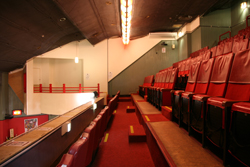
Q: When I visited Asakusa France-za a long time ago, I saw some professional comic storytellers, including Bunraku Katsura and Shinsho Kokontei. It was the time when Shinji Maki, a comic-chat artiste, Two Beat, a comedy duo, and Pinko Izumi were performed, wasn't it? I remember that Pinko Izumi did stand-up comedy while playing guitar.
Matsukura : Maybe it was the time when Beat Takeshi (Takeshi Kitano) appeared on the stage. It was not a long time ago. At that time, Pinko Izumi belonged to Shinji Maki's agency.
Q: When was Asakusa France-za renamed to the present-day name?
Asakusa France-za was temporarily renamed to Toyo Gekijo, and Asakusa France-za was moved to the 4th and 5th floors. Asakusa France-za was located just above Toyo Gekijo. Asakusa France-za continued to exist when Takeshi Kitano appeared on the state and after he left the stage, but it was finally closed, and the 4th floor was used for a vaudeville theater, and the 5th for a hall to perform comic dialogues and skits.
Q: Were Shinsuke Minami and Kiyoshi Atsumi considered to be senior performers here?
Yes, Shinsuke Minami mainly performed in Shinjuku France-za. Shinjuku France-za stood in a site where an annex to Isetan is now located. At that time, there was a light drama hall called "Moulin Rouge," but later it was closed, so entertainers belonged to Moulin Rouge, including Shinsuke Minami, moved to this hall.
Q: Did entertainers in those days exclusively belong to a hall?
Yes, they exclusively belonged to a hall. Since Kiyoshi Atsumi was a main entertainer in Asakusa France-za, Shinsuke Minami had no room to activity perform in it. So he transferred to Shinjuku France-za, and played light dramas with Toshiaki Minami and Shiro Ito.
Q: I heard that Shiro Ito worked at Waseda University Co-operative.
Shiro Ito visited this hall because he was a staff member of Waseda University. He wanted to appear on the stage, but there were many performers in those days, so he had no role to play. So he was ordered that, when those performers did a night-time job at cabarets, he should follow them. As a result, he became an actor without any reason.
Q: Could you guide me through the hall?
This is a dressing room. It looks like this (see the right picture). Costumes of performers are hung up here. Now, a minor performer is writing a program of the day on Neta-cho. In this way, a minor performer should write down performers' names and what they play every day. There is a custom that comic turns performed before should not be performed by other performers. So performers can decide what they perform. (continued in the lower column)
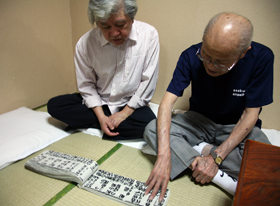
Q: Are Yose characters used?
This is written by a minor performer's hand handwriting. "Mekuri," a program board placed on the stage, is written in Yose characters, such as "Kantei-ryu Moji," or Kantei school's characters. Mekuri is written by specialists for Yose characters. (continued in the right column)
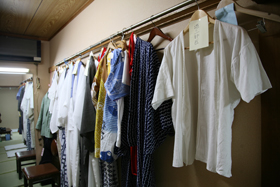
Q: Is this dressing room used by all performers?
This room was formerly the back of the stage, but was converted into a dressing room. This is a dressing room for comic storytellers. Entertainers who performe the so-called "Iromono," such as comic dialogues and comedy skits, use a dressing room on the 2nd floor.
Q: Is this room used by musical accompanists? How many musical accompanists are there?
There are two musical accompanists. In addition to the musical accompanists, minor performers beat drums and ring bells.
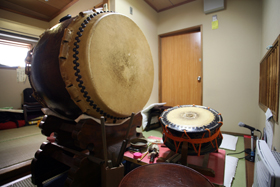
Q: What are characters written on the back of the stage? Are ideas for performances written (see the picture below)?
Those are graffiti. Minor performers write what they want on the wall. Major performers can enter the dressing room, but minor performers cannot, so they stand by around here. If they are here, they can hear what major performers talk on the stage, so they can learn something. Those lockers are also used by minor performers.
(continued in the lower column)
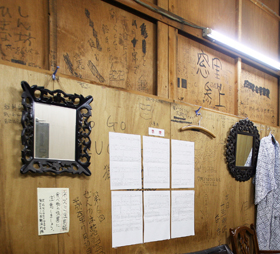
About the dressing room on the 2nd floor
Kiyoshi Atsumi used to sit around here. That table was extended over there. The window was also longer in those days. Because there were many performers.
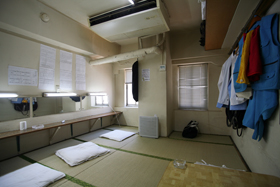
Q: Did performers go down to the 1st floor from this dressing room on the 2nd floor, and appeared on the stage?
At that time, this room had a window through which the stage could be seen. Performers used to see the stage from here, and decided the time to go down to the stage.
Q: When do entertainers enter the dressing room?
They enter the dressing room about 2-3 hours before appearing on the stage. Popular and busy entertainers jump into the room, saying, "Sorry to be late.”
Q: Do young entertainers appear on the stage of Toyokan? Are the types of audience different between Asakusa Engei Hall and Toyokan?
Well, some audiences see the both stages. Other audiences see the stage of Toyokan, and come back to Asakusa Engei Hall. Nevertheless, the types of audience are different. Audiences who like Rakugo comic storytelling come to Asakusa Engei Hall. Audiences who like the so-called Iromono, such as comic dialogues and skits, come to Toyokan. (continued in the next page)
